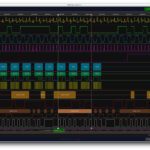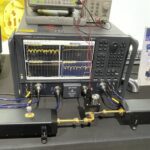By connecting to a computer, a USB oscilloscope lets engineers offload screens and compute-intensive functions to the host, which reduces needed bench space and brings portability.
Oscilloscopes are sometimes grouped into three types, benchtop, portable, and USB. The first two types are self-contained, but USB oscilloscopes are not. They consist of the electronics that capture and condition the signal being investigated, a PC, usually a laptop or tablet model but sometimes a mobile phone handset, and software that’s optimized for use with the oscilloscope hardware. They’re called USB oscilloscopes because they connect to the PC with a USB cable that also powers the signal capture and conditioning electronics.
USB oscilloscopes can deliver most of the same functions as their benchtop and portable cousins, but they can fit into a pocket because they rely on the PC for memory and computing power, and that makes them inexpensive (Figure 1). The interface is a big difference, and it’s both a benefit and bane of USB oscilloscope users. In some instances, having to control the operation using mouse clicks and sliders can be less efficient than using the knobs and dials of a conventional oscilloscope. On the other hand, the PC can bring a great deal of computing power and analytical flexibility, including the opportunity to develop custom analysis software.

USB oscilloscopes are available from one to eight channels. Depending on the software offered, they can be used as spectrum analyzers, function generations arbitrary waveform generators, protocol decoders, and some mixed signal models can be used as logic analyzers. Some have flexible display support and can accommodate a range of display resolutions, up to 4K, or can display the results across multiple monitors. Independent channels can show different views of the same data.
High-performance models are available that are suitable for a variety of applications:
- Telecommunications and radar test, service, and manufacturing
- Eye diagram, mask, and limits test up to 8 Gb/s
- Optical fiber, transceiver, and laser testing
- Gigabit digital system measurements
- Precision timing and phase analysis
- Digital system design and characterization
- Ethernet, HDMI, PCI, SATA, and USB analysis
- Semiconductor characterization
Power and pen oscilloscopes
Because USB oscilloscopes don’t have dials, knobs, or a display, they can take many physical forms. AC power measurements can be made using a purpose-built phase measurement USB oscilloscope, or three can be used together for three-phase power measurements. These optically isolated units have a 16-bit resolution for accurate power analysis. The measurement software can capture measurements over an extended period. It’s mostly targeted at industrial maintenance and troubleshooting but can also be used for analysis of ac/dc power supply performance (Figure 2).

Another USB oscilloscope is configured like an expanded probe and is designed for one-handed use. Users can change the voltage/time division with a single hand without referring to the host PC. It includes an LED light to illuminate the immediate work area and can perform 20 automatic measurements. It’s designed for use in low-voltage circuits up to ±50 V and has voltage ranges from 20mV to 20V per division.
Summary
USB oscilloscopes are available with a wide range of performance capabilities from models designed for relatively simple maintenance and troubleshooting activities up to units that can support design analysis of high-performance RF, optical and digital systems. USB oscilloscopes rely on an external PC for computing and memory. That enables users to easily upgrade the overall system’s computing power. USB oscilloscopes support the use of high-resolution monitors and the development of custom data and signal analysis software.
References
Handyscope USB power quality analyzer, TiePie
Ultra-compact PC oscilloscopes, PicoScope
USB Pen Storage Oscilloscope, Hantek
What is a USB Oscilloscope, Compocket







Leave a Reply
You must be logged in to post a comment.